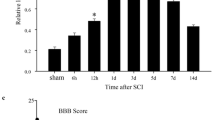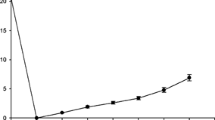Abstract
CUG-binding protein 1, a member of the CELF (CUGBP and embryonic lethal abnormal vision-like factor) family of RNA-binding proteins, is shown to be multifunctional, regulating many posttranscriptional processes including alternative splicing, deadenylation, mRNA decay, and translation. Recently, CUGBP1 is found to represses p27 IRES activity and inhibits expression of endogenous p27 in cultured breast cancer cells. However, the roles of CUGBP1 in central nervous system injury remain unknown. In our study, we performed acute spinal cord injury (SCI) model in adult rats in order to research the expression changes of CUGBP1 in spinal cord. Western blot analysis showed a marked upregulation of CUGBP1 after SCI. Immunohistochemistry analysis revealed a wide distribution of CUGBP1 in the spinal cord. Double immunofluorescence staining indicated that CUGBP1 immunoreactivity was increased predominantly in neurons and astrocytes after SCI. Moreover, colocalization of CUGBP1/proliferating cell nuclear antigen (PCNA) was detected in GFAP positive cells. We also examined the expression profiles of p27, which was up-regulated after SCI. To further understand whether CUGBP1 plays a role in astrocyte proliferation, we applied LPS to induce astrocyte proliferation in vitro. Western blot analysis demonstrated that CUGBP1 expression was positively correlated with PCNA expression, and the p27 expression was negatively correlated with CUGBP1 expression following LPS stimulation. Our results suggest that CUGBP1 might be implicated in the pathophysiology of spinal cord after SCI.






Similar content being viewed by others
Abbreviations
- CUGBP1:
-
CUG-binding protein 1
- SCI:
-
Spinal cord injury
- BSA:
-
Bovine serum albumin
- DAB:
-
Diaminobenzidin
- PCNA:
-
Proliferating cell nuclear antigen
- NeuN:
-
Neuronal nuclei
- GFAP:
-
Glial fibrillary acidic protein
- GAPDH:
-
Glyceraldehyde-3-phosphate dehydrogenase
References
Kwon BK, Tetzlaff W, Grauer JN, Beiner J, Vaccaro AR (2004) Pathophysiology and pharmacologic treatment of acute spinal cord injury. Spine J: Off J North Am Spine Soc 4:451–464
Zhang J, Cui Z, Shen A, Li W, Xu G, Bao G, Sun Y, Wang L, Gu H, Zhou Y (2013) Upregulation of myelin and lymphocyte protein (MAL) after traumatic spinal cord injury in rats. J Mol Histol 44:125–134
Xu D, Cui S, Sun Y, Bao G, Li W, Liu W, Zhu X, Fan J, Wang Y, Cui Z (2011) Overexpression of glucose-regulated protein 94 after spinal cord injury in rats. J Neurol Sci 309:141–147
Popovich PG, Guan Z, McGaughy V, Fisher L, Hickey WF, Basso DM (2002) The neuropathological and behavioral consequences of intraspinal microglial/macrophage activation. J Neuropathol Exp Neurol 61:623–633
Hermann GE, Rogers RC, Bresnahan JC, Beattie MS (2001) Tumor necrosis factor-α induces cFOS and strongly potentiates glutamate-mediated cell death in the rat spinal cord. Neurobiol Dis 8:590–599
Schwab ME, Bartholdi D (1996) Degeneration and regeneration of axons in the lesioned spinal cord. Physiol Rev 76:319–370
Fawcett JW, Asher RA (1999) The glial scar and central nervous system repair. Brain Res Bull 49:377–391
Condic ML, Lemons ML (2002) Extracellular matrix in spinal cord regeneration: getting beyond attraction and inhibition. Neuroreport 13:A37–A48
Vlasova IA, Tahoe NM, Fan D, Larsson O, Rattenbacher B, Sternjohn JR, Vasdewani J, Karypis G, Reilly CS, Bitterman PB, Bohjanen PR (2008) Conserved GU-rich elements mediate mRNA decay by binding to CUG-binding protein 1. Mol Cell 29:263–270
Timchenko NA, Cai ZJ, Welm AL, Reddy S, Ashizawa T, Timchenko LT (2001) RNA CUG repeats sequester CUGBP1 and alter protein levels and activity of CUGBP1. J Biol Chem 276:7820–7826
Apponi LH, Corbett AH, Pavlath GK (2011) RNA-binding proteins and gene regulation in myogenesis. Trends Pharmacol Sci 32:652–658
Good PJ, Chen Q, Warner SJ, Herring DC (2000) A family of human RNA-binding proteins related to the Drosophila Bruno translational regulator. J Biol Chem 275:28583–28592
Timchenko NA, Welm AL, Lu X, Timchenko LT (1999) CUG repeat binding protein (CUGBP1) interacts with the 5′ region of C/EBPβ mRNA and regulates translation of C/EBPβ isoforms. Nucleic Acids Res 27:4517–4525
Gareau C, Fournier MJ, Filion C, Coudert L, Martel D, Labelle Y, Mazroui R (2011) p21(WAF1/CIP1) upregulation through the stress granule-associated protein CUGBP1 confers resistance to bortezomib-mediated apoptosis. PLoS ONE 6:e20254
Chang ET, Donahue JM, Xiao L, Cui Y, Rao JN, Turner DJ, Twaddell WS, Wang JY, Battafarano RJ (2012) The RNA-binding protein CUG-BP1 increases survivin expression in oesophageal cancer cells through enhanced mRNA stability. Biochem J 446:113–123
Kress C, Gautier-Courteille C, Osborne HB, Babinet C, Paillard L (2007) Inactivation of CUG-BP1/CELF1 causes growth, viability, and spermatogenesis defects in mice. Mol Cell Biol 27:1146–1157
Mukhopadhyay D, Jung J, Murmu N, Houchen CW, Dieckgraefe BK, Anant S (2003) CUGBP2 plays a critical role in apoptosis of breast cancer cells in response to genotoxic injury. Ann NY Acad Sci 1010:504–509
Xiao L, Cui YH, Rao JN, Zou T, Liu L, Smith A, Turner DJ, Gorospe M, Wang JY (2011) Regulation of cyclin-dependent kinase 4 translation through CUG-binding protein 1 and microRNA-222 by polyamines. Mol Biol Cell 22:3055–3069
Choi WT, Folsom MR, Azim MF, Meyer C, Kowarz E, Marschalek R, Timchenko NA, Naeem RC, Lee DA (2007) C/EBPβ suppression by interruption of CUGBP1 resulting from a complex rearrangement of MLL. Cancer Genet Cytogenet 177:108–114
Rattenbacher B, Beisang D, Wiesner DL, Jeschke JC, von Hohenberg M, St Louis-Vlasova IA, Bohjanen PR (2010) Analysis of CUGBP1 targets identifies GU-repeat sequences that mediate rapid mRNA decay. Mol Cell Biol 30:3970–3980
Byrnes KR, Faden AI (2007) Role of cell cycle proteins in CNS injury. Neurochem Res 32:1799–1807
Di Giovanni S, Movsesyan V, Ahmed F, Cernak I, Schinelli S, Stoica B, Faden AI (2005) Cell cycle inhibition provides neuroprotection and reduces glial proliferation and scar formation after traumatic brain injury. Proc Natl Acad Sci USA 102:8333–8338
Hilton GD, Stoica BA, Byrnes KR, Faden AI (2008) Roscovitine reduces neuronal loss, glial activation, and neurologic deficits after brain trauma. J Cereb Blood Flow Metab: Off J Int Soc Cereb Blood Flow Metab 28:1845–1859
Kabadi SV, Stoica BA, Loane DJ, Byrnes KR, Hanscom M, Cabatbat RM, Tan MT, Faden AI (2012) Cyclin D1 gene ablation confers neuroprotection in traumatic brain injury. J Neurotrauma 29:813–827
Tian DS, Dong Q, Pan DJ, He Y, Yu ZY, Xie MJ, Wang W (2007) Attenuation of astrogliosis by suppressing of microglial proliferation with the cell cycle inhibitor olomoucine in rat spinal cord injury model. Brain Res 1154:206–214
Tian DS, Yu ZY, Xie MJ, Bu BT, Witte OW, Wang W (2006) Suppression of astroglial scar formation and enhanced axonal regeneration associated with functional recovery in a spinal cord injury rat model by the cell cycle inhibitor olomoucine. J Neurosci Res 84:1053–1063
Byrnes KR, Stoica BA, Fricke S, Di Giovanni S, Faden AI (2007) Cell cycle activation contributes to post-mitotic cell death and secondary damage after spinal cord injury. Brain: J Neurol 130:2977–2992
Di Giovanni S, Knoblach SM, Brandoli C, Aden SA, Hoffman EP, Faden AI (2003) Gene profiling in spinal cord injury shows role of cell cycle in neuronal death. Ann Neurol 53:454–468
Fillies T, Woltering M, Brandt B, Van Diest JP, Werkmeister R, Joos U, Buerger H (2007) Cell cycle regulating proteins p21 and p27 in prognosis of oral squamous cell carcinomas. Oncol Rep 17:355–359
Sgambato A, Migaldi M, Leocata P, Ventura L, Criscuolo M, Di Giacomo C, Capelli G, Cittadini A, De Gaetani C (2000) Loss of p27Kip1 expression is a strong independent prognostic factor of reduced survival in N0 gastric carcinomas. Cancer 89:2247–2257
Zheng Y, Miskimins WK (2011) CUG-binding protein represses translation of p27Kip1 mRNA through its internal ribosomal entry site. RNA Biol 8:365–371
Sun LL, Cheng C, Liu HO, Shen CC, Xiao F, Qin J, Yang JL, Shen AG (2007) Src suppressed C kinase substrate regulates the lipopolysaccharide-induced TNF-α biosynthesis in rat astrocytes. J Mol Neurosc: MN 32:16–24
Brahmachari S, Fung YK, Pahan K (2006) Induction of glial fibrillary acidic protein expression in astrocytes by nitric oxide. J Neurosci: Off J Soc Neurosci 26:4930–4939
Go HS, Shin CY, Lee SH, Jeon SJ, Kim KC, Choi CS, Ko KH (2009) Increased proliferation and gliogenesis of cultured rat neural progenitor cells by lipopolysaccharide-stimulated astrocytes. Neuroimmunomodulation 16:365–376
Bao Y, Qin L, Kim E, Bhosle S, Guo H, Febbraio M, Haskew-Layton RE, Ratan R, Cho S (2012) CD36 is involved in astrocyte activation and astroglial scar formation. J Cereb Blood Flow Metab: Off J Int Soc Cereb Blood Flow Metab 32:1567–1577
Busch SA, Silver J (2007) The role of extracellular matrix in CNS regeneration. Curr Opin Neurobiol 17:120–127
Karimi-Abdolrezaee S, Billakanti R (2012) Reactive astrogliosis after spinal cord injury—beneficial and detrimental effects. Mol Neurobiol 46:251–264
McKeon RJ, Schreiber RC, Rudge JS, Silver J (1991) Reduction of neurite outgrowth in a model of glial scarring following CNS injury is correlated with the expression of inhibitory molecules on reactive astrocytes. J Neurosci: Off J Soc Neurosci 11:3398–3411
White RE, Jakeman LB (2008) Don’t fence me in: harnessing the beneficial roles of astrocytes for spinal cord repair. Restor Neurol Neurosci 26:197–214
Wu J, Stoica BA, Dinizo M, Pajoohesh-Ganji A, Piao C, Faden AI (2012) Delayed cell cycle pathway modulation facilitates recovery after spinal cord injury. Cell Cycle 11:1782–1795
Lee J, Kim SS (2009) The function of p27 KIP1 during tumor development. Exp Mol Med 41:765–771
Herrup K, Yang Y (2007) Cell cycle regulation in the postmitotic neuron: oxymoron or new biology? Nat Rev Neurosci 8:368–378
Liu DZ, Ander BP (2012) Cell cycle inhibition without disruption of neurogenesis is a strategy for treatment of aberrant cell cycle diseases: an update. Sci World J 2012:491737
Yang Y, Herrup K (2007) Cell division in the CNS: protective response or lethal event in post-mitotic neurons? Biochim Biophys Acta 1772:457–466
Acknowledgments
This work was supported by the National Natural Science Foundation of China (No. 81271367).
Author information
Authors and Affiliations
Corresponding author
Ethics declarations
Conflict of Interest
The authors have no conflicts of interest to declare.
Additional information
Longfei Yang and Jinlong Zhang have contributed equally to this work.
Rights and permissions
About this article
Cite this article
Yang, L., Zhang, J., Chen, J. et al. The Expression of CUGBP1 After Spinal Cord Injury in Rats. Neurochem Res 40, 1966–1975 (2015). https://doi.org/10.1007/s11064-015-1692-0
Received:
Revised:
Accepted:
Published:
Issue Date:
DOI: https://doi.org/10.1007/s11064-015-1692-0




